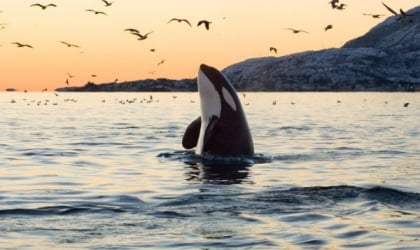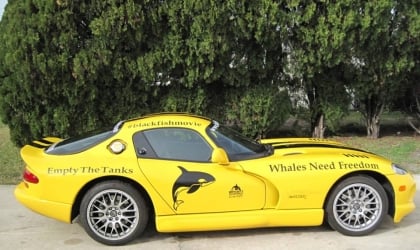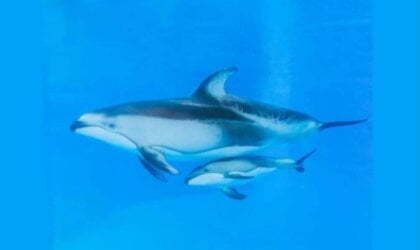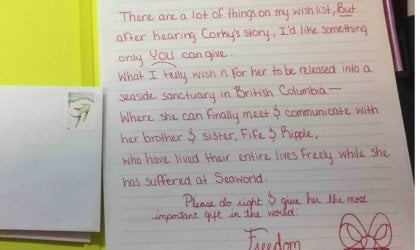Did you know that 20 Commerson’s dolphins — also known as “skunk dolphins” or “panda dolphins” — reportedly died on SeaWorld’s watch in less than 30 years?
Because Commerson’s dolphins are naturally active animals with high energy, humans who hope to exploit them have found it difficult to train them or force them to perform. So when SeaWorld couldn’t use these dolphins in shows, it moved them from tank to tank.
Some Commerson’s dolphins who formerly lived in SeaWorld parks are now at Aquatica Orlando, a sister park to SeaWorld located in Florida. There, these complex animals live in a small tank with a water slide running through it. Aquatica Orlando visitors likely have no idea that an entrance ticket supports such exploitation.
The Sad Story of Betsy, a Commerson’s Dolphin Exploited at Marine Parks
Betsy was just a baby when she was caught in the ocean and transferred to SeaWorld in 1983. Eleven other dolphins were also captured at this time, and half of the group died within a year.
As days turned to months, months turned to years, and years turned to decades, Betsy’s world—which once consisted of vast open ocean waters and her family pod—became smaller and smaller as she was forced to live in SeaWorld’s chlorinated, concrete tanks. Her only species-specific companions were Juan and his offspring Ringer, and the park did nothing to prevent them from mating with one another. Betsy witnessed the loss of two of Ringer’s babies—one was stillborn, and the other died a few days after birth.
As criticism rose against SeaWorld and its cruel confinement of orcas and other dolphins faced even higher scrutiny, the money-hungry company saw an opportunity to make a profit by relocating Betsy, Juan, and Ringer. Since they don’t have the same money-making appeal as orcas, they were put into tanks with beluga whales. These two species live in completely different parts of the world and are incompatible with one another in captivity: The larger belugas often took out their frustrations on the smaller dolphins.
Betsy, Juan, and Ringer were reportedly moved to a tank in the back of SeaWorld San Diego since they were unpopular with visitors. All three were then shipped across the country to SeaWorld’s sister park, Aquatica Orlando, in January 2016.
Days after the move, Betsy died at age 33.
In 2017, Ringer gave birth to a third calf, but the newborn lived for only a few days. Four years later, in 2021, Ringer died at Aquatica Orlando.
Juan remains at the Orlando abusement park, where he’s confined with two other Commerson’s dolphins named Ross and Pepe, who were sent to Aquatica Orlando in 2008. Two of their former tankmates, Fabio and Keebler, both died in 2014.
Juan, who was captured off the coast of Chile in 1983, has spent more than 40 years in tiny tanks.
Fed an Unnatural Diet
A video posted to YouTube reveals that Juan typically eats between eight and 13 pounds of food a day, some of which is gelatin—a protein obtained by boiling animals’ skin, tendons, ligaments, or bones.
Gelatin Is Not a Natural Food for Commerson’s Dolphins
In nature, these dolphins eat a variety of fresh prey—including hake, sardines, silversides, squids, marine worms, and shrimp—and they sometimes dine on seaweed. But at Aquatica Orlando, they’re fed dead fish and gelatin.
Attempts to Breed Commerson’s Dolphins Failed
SeaWorld attempted to breed the population over the years, but artificial insemination didn’t work well. Many natural births led to numerous stillborn calves or calves who died young.
SeaWorld no longer breeds Commerson’s dolphins, but the company does still forcibly breed bottlenose and Pacific white-sided dolphins. This means that the remaining Commerson’s dolphins at Aquatica Orlando will be the last in the U.S. sentenced to life in concrete tanks.
As of 2022, there were just six other Commerson’s dolphins in captivity elsewhere in the world, all in Japan—two at Sendai Umino-Mori Aquarium and four at Toba Aquarium. In 1987, 17 Commerson’s dolphins were sent from Chile to Japan.
Facts About Commerson’s Dolphins in Their Natural Habitat
These dolphins typically live in small groups of fewer than 10 individuals, but they sometimes gather in groups of up to 100 for feeding or breeding. One population lives along the coast of southern South America, while a second resides in coastal waters around the Kerguelen Islands in the southern Indian Ocean.
Commerson’s dolphins are agile swimmers who’ve been observed swimming upside down and spinning underwater. They often ride waves close to the shoreline, where they frequently can be seen jumping out of the water. They’ve been known to swim with other cetacean species, including Peale’s dolphins, Burmeister’s porpoises, and Chilean dolphins.
Dolphins are highly intelligent and social animals. In the open ocean, they navigate by echolocation. But in marine parks, they’re forced to swim in endless circles, with their sonar bouncing off walls.
More Than 500 Dolphins and Whales Have Died on SeaWorld’s Watch
You Can Help Commerson’s Dolphins and Other Animals in Marine Parks
Please, never go to Aquatica Orlando or any SeaWorld park. Urge your friends, family members, and social media followers to do the same.
Join the thousands of conscientious people who’ve urged SeaWorld to stop breeding marine mammals and send the animals to seaside sanctuaries. There, they could live in large areas of the ocean while still receiving care from humans.





